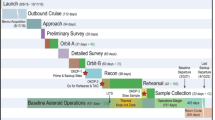Abstract
When the orbit of the Landsat I spacecraft was liberated to natural forces, the loss of observations to the remote sensing community was balanced by a modest gain for geodesy. The orbit’s long ground-track repeat period of eighteen days gives rise to a shallow resonance with fourteenth, twenty-eighth and forty-second order terms in the geopotential. A single continuous span of twenty-four days of Unified S-Band tracking data, collected at a single station in 1976, has been analyzed to define constraints on the dominant resonance terms of these orders and of fourteenth-order fringe resonance effects depending on the eccentricitye≈.002. Tracking observations from other stations collected during 1974 and 1975 gave essentially the same results, which provided error estimates for the lumped resonance coefficients. The application of the resonance model can considerably improve the definition and prediction of the Landsat 1 orbit. Direct numerical estimates of the influence coefficients in the resonance constraint equations were made to confirm the accuracy of analytical expressions which allow the equations to be applied to geopotential fields of arbitrarily high degree and order. Several recently derived gravity fields were tested against the Landsat resonance constraints and their comparative agreement is discussed.
Similar content being viewed by others
References
R.R. ALLAN: “Resonance Effects Due to the Longitude Dependence of the Gravitational Field of a Rotating Primary”, Plan. Space Sci., Vol. 15, pp. 53–76, 1967.
R.R. ALLAN: “Satellite Resonance with Longitude-Dependent Gravity-III. Inclination Changes for Close Satellites”, Plan. Space Sci., Vol. 21, pp. 205–225, 1973.
R.J. ANDERLE: “Observations of Resonance Effects on Satellite Orbits Arising from the Thirteenth- and Fourteenth-Order Gravitational Coefficients”, J.G.R., Vol. 70, No. 10, pp. 2453–2458, 1965.
R.J. ANDERLE and S.J. SMITH: “Observations of Twenty-Seventh and Twenty-Eighth Order Gravity Coefficients Based on Doppler Observations”, J. Astron. Sc., Vol. XV, No. 1, pp. 1–4, 1968.
G. BALMINO, C. REIGBER and B. MOYNOT: “The GRIM-2 Earth Gravity Field Model”. Deutsche Geodatische Kommission, Reihe A, Heft No. 86, 1976.
B.C. DOUGLAS and J.G. MARSH: “GEOS-2 and 13th Order Terms of the Geopotential”, Celestial Mechanics 1, pp. 479–490, 1970.
A.J. FUCHS and R.A. STRAFELLA: “ERTS Orbit Selection Analysis”. NASA X-832-70-144, April 1970.
E.M. GAPOSCHKIN: “Gravity-field Determination from Laser Observations”, Phil. Trans. R. Soc. Lond. A. 284, 515–527, May 1977.
R.H. GOODING: “Lumped Fifteenth Order Harmonics in the Geopotential”, Nature, Vol. 231, pp. 168–169, June 1971.
H. HILLER: “Geophysical Interpretation of the Orbit of 1971-18B”. RAE Tech. Rept. 787, 1978.
L.G. JACCHIA: “Revised Static Models of the Thermosphere and Exosphere with Empirical Temperature Profiles”. S.A.O. Special Report 332, Cambridge, 1971.
W.M. KAULA: “Theory of Satellite Geodesy”. Chapter 3, Blaisdell, 1966.
D.G. KING-HELE, D.M.C. WALKER and R.H. GOODING: “Geopotential Harmonics of Order 15 and Odd Degree from Analysis of Resonant Orbits”, Plan. Space Sci., Vol. 23, pp. 1239–1256, 1975.
D.G. KING-HELE, D.M.C. WALKER and R.H. GOODING: “Evaluation of Fourteenth-Order Harmonics in the Geopotential”, Plan. Space Sci., Vol. 27, pp. 1–18, 1979.
J. KLOKOCNIK: “Changes in the Inclination of a Close Earth Satellite due to Orbital Resonances”. Bull. Astron. Inst. Czech., Vol. 27, No. 5, pp. 287–295, 1976.
J. KLOKOCNIK: “Fourteenth and Twenty-Eighth Order Lumped Coefficients from the changes of the Orbital Inclination of the Interkosmos 9 and 10 Satellites”, Bull. Astron. Inst. Czech., Vol. 28, No. 5, pp. 291–299, 1977.
F.J. LERCH, S.M. KLOSKO, R.E. LAUBSCHER and C.A. WAGNER: “Gravity Model Improvement Using GEOS 3 (GEM 9 and 10)”. J.G.R., Vol. 84, No. B8, July 1979.
NASA: “Design Study Specifications for ERTS-A and B”. GSFC 5-701-P-3, October 1969.
NASA: “STDN Validation and Evaluation Report”. Tracking Data Evaluation Section, GSFC, DEO-72-244, October 1972.
“NASA Directory of Observation Station Locations”. Vol. I, Operational Orbit Support Branch, GSFC, November 1973.
B. PUTNEY: “General Theory for Dynamic Satellite Geodesy”. National Geodetic Satellite Program Part I, Section 5.4.1, pp. 319–334, NASA SP-365, 1977.
C. REIGBER and G. BALMINO: “Fourteenth Order Harmonics from Analysis of Mean Longitude Variations of Resonant Satellites”. Paper 1.2.5, COSPAR XIX, Philadelphia, June 1976.
W.P. VARSON: “Functional Description of Unified S-Band Systems and Integration into the Manned Space Flight Network”. Proc. Apollo USB Tech. Conf., NASA SP-87, pp. 3–12, July 1965.
C.A. WAGNER: “The Accuracy of Goddard Earth Models”. NASA X-921-76-187, June 1976.
C.A. WAGNER and S.M. KLOSKO: “Gravitational Harmonics from Shallow Resonant Orbits”, Celestial Mechanics 16, pp. 143–163, 1977.
C.A. WAGNER, F.J. LERCH, J.E. BROWND and J.S. RICHARDSON: “Improvements in the Geopotential Derived from Satellite and Surface Data (GEM 7 and 8)”. J.G.R., Vol. 82, No. 5, February 1977.
C.A. WAGNER and O.L. COLOMBO: “Gravitational Spectra from Direct Measurements”, J.G.R., Vol. 84, No. B9, pp. 4699–4712, 1979.
D.M.C. WALKER: “Upper Atmosphere Rotation Rate from Analysis of the Orbital Inclination of Explorer I”. Plan. Space Sci., Vol. 23, pp. 1573–1579, 1975.
Author information
Authors and Affiliations
Rights and permissions
About this article
Cite this article
Dunn, P. Geopotential resonance in a Landsat orbit. Bull. Geodesique 55, 143–158 (1981). https://doi.org/10.1007/BF02530836
Received:
Accepted:
Published:
Issue Date:
DOI: https://doi.org/10.1007/BF02530836



